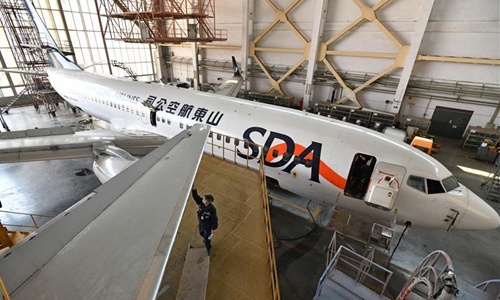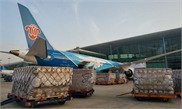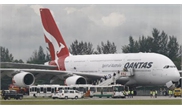SOURCE / MARKETS
Further routes and frequencies announced as countries begin to lift travel bans
More airlines resume flights to China

A technician refits an airliner at Taikoo (Shandong) Aircraft Engineering Company Limited (STAECO) in Jinan, east China's Shandong Province, April 27, 2020. The COVID-19 pandemic has led to a significant decrease in airline travel and passenger revenue. Since its production recovered on Feb. 10, STAECO has been offering Passenger-to-Freighter (PTF) solutions for airline operators which need more cargo planes to address this market change. So far, the company has accomplished three PTF conversions for its clients. (Xinhua/Zhu Zheng)
More overseas airlines are planning to resume international flights to China as blockade measures and travel bans imposed by some countries and regions are gradually coming to an end.
Qatar Airways said on Wednesday that it will begin a phased approach to expanding its network in line with passenger demand evolution and the expected relaxation of entry restrictions around the world.
By the end of June, the aim is to have 80 destinations scheduled including 33 in the Asia-Pacific region, covering Beijing, Shanghai and Guangzhou, the carrier said.
Anadolu Agency reported on Wednesday that Turkey's national carrier will resume domestic flights in June and reintroduce international flights slowly.
According to the three-month flight plan, the carrier will fly to 22 destinations in 19 countries from June, including Canada, Kazakhstan, Afghanistan, Japan and China, with a weekly frequency of 75 flights.
Fortune reported earlier this month that United Airlines is planning a strong return to China in June and will "pencil in" a relaunch of passenger services with four flights to three cities - Beijing, Chengdu, and Shanghai.
"We will also pencil in four China routes in the June schedule," United said in an employee memo. "We continue to work out the feasibility of restarting passenger service to China," according to the report.
Air Canada announced earlier that it will resume flights from Vancouver to Beijing and Shanghai from June 1, and tentatively resume Toronto and Montreal flights to and from China after June 23.
Normally, the peak season for foreign airlines starts at Easter, with millions of passengers traveling for holidays until September. However, due to the pandemic and travel restrictions, airlines have been grounding flights one after another, and the global aviation industry is suffering perhaps its darkest moment, although some positive signs can be seen in some countries and regions.
Some airlines have begun gradually resuming commercial passenger flights, but industry market watchers still doubt the aviation market will return to its previous boom.
The International Air Transport Association (IATA) announced its global passenger traffic data for March 2020, showing demand (measured in total revenue passenger kilometers or RPKs) dived 52.9 percent compared to the same period a year ago. That was the largest decline in recent history.
International passenger demand in March shrank 55.8 percent compared to March 2019. That is much worse than the 10.3 percent year-on-year decline in February. All regions recorded double-digit percentage traffic declines. Capacity tumbled 42.8 percent, and the load factor plunged 18.4 percentage points to 62.5 percent.
IATA even warned that the COVID-19 crisis will see airline passenger revenues drop by $314 billion in 2020, a 55 percent decline compared to 2019.
"The resumption of international routes shows demand is high, especially for the market between China and the US," veteran industry market watcher Lin Zhijie told the Global Times.
Chinese State Councilor and Foreign Minister Wang Yi said in September 2019 that five million people travel between China and the US each year. On average, 17,000 people travel between China and the US every day, with a flight taking off and landing every 17 minutes.
However, Zheng Hongfeng, CEO of industry information provider VariFlight, holds a dim outlook on the resumption of international flights: "The core of airline resumption is not the airlines, but whether governments of different countries are willing to let planes arrive in their countries."



